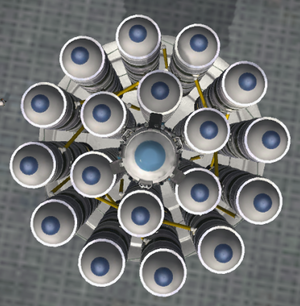Asparagus staging
Asparagus staging is a rocket design method. It involves using parallel engines and fuel crossfeeds to increase initial thrust and available fuel while reducing the dry mass of later stages. The stock vessel Kerbal X demonstrates this technique.
Extensive asparagus staging was very effective in building efficient rockets in early versions of Kerbal Space Program. Several updates gradually made the drag model of the game more realistic, making asparagus staging less effective, and added larger, higher-efficiency engines, giving effective alternatives for building large rockets. In modern versions of the game, it is usually better to use a single large main engine per stage and a less complex arrangement of boosters.
The technique is still useful for building exceptionally large rockets when no larger engines are available.
Function
The idea is to create a rocket with a lot of parallel engines each carrying fuel. Firing these engines in parallel allows for higher initial thrust than sequential staging. The trick, however, is that each rocket engine isn't depleting its own tank, but they are all draining their fuel from the outermost tanks. When these are depleted, the outermost tanks and their engines are decoupled, and the next fuel tank takes over which is still completely full. The result is that the rocket always flies with the minimum number of tanks required to transport the fuel it has left while also constantly using all engines it has on board. Ideally, this can allow lifting heavier payloads.
This can be implemented in the VAB by attaching fuel lines in the order stages will be dropped, or by staging decouplers with crossfeed enabled.
Disadvantages
Extensive asparagus staging can be complex to build. Such designs cannot take full advantage of symmetry modes in the VAB. Placing only two mirrored engines and their fuel lines at a time can leave engines at subtly different heights, inducing a torque on the craft. It is preferable to add the boosters first with full symmetry, and then place each fuel line manually.
Since each engine stack carries its own fuel but only the central stack carries the payload, if stacks are otherwise identical, the asparagus staged rocket's thrust-to-weight ratio will be reduced with each subsequent staging. So it can be difficult to have efficient thrust-to-weight ratios at each point of a many-staged launch.
More layers of fuel stacks and struts, which may be required for more massive payloads, lead to high part counts. High part counts can lead to slowdowns and lower frame rates.
Uneven reduction of mass at different angles around the craft can lead the rocket to start to roll, which might result in a loss in control.
Beyond in-game functionality, the appearance of a "matchstick bundle" may seem un-aesthetic, and, as discussed below, the designs are less true to real-world rockets.
Using larger central engines may achieve equal performance with a lower part count, more stability in flight, improved aesthetics, and greater realism. Additionally, in career mode, using solid fuel boosters may be a cheaper way to achieve a given delta-v than using liquid boosters with asparagus staging.
Drag
With the the release of version 1.0, a more realistic drag and aerodynamics model was introduced, and in version 1.2 trans- and supersonic drag was further increased for blunt objects. This made designing wide asparagus-staged craft far more challenging and reduced its efficiency relative to more conventional staging.
Limited asparagus staging as seen in the Kerbal X can still be effective.
Booster stages which are slanted away from central rockets reduce frontal drag, and help make limited asparagus staging more viable. Three slanted adapter fuel tanks were introduced in 0.90.0, and the slanted FL-C1000 Fuel Tank, modeled after the real-world Soviet R-7 boosters, is available with the Making History DLC.
Real world application
Asparagus staging, properly known as a propellant crossfeed system, has not yet appeared in real-world rockets, though it has been proposed multiple times.
The "asparagus" name is found in a book on orbital mechanics by Tom Logsdon. According to Logsdon, an engineer named Ed Keith coined the term "asparagus-stalk booster" for launch vehicles using propellant crossfeed.[1]
In 1947, Mikhail Tikhonravov developed plans for parallel staging with propellant crossfeed, which he called “packet rockets”. This led to the development of the R-7 Semyorka and the rest of the R-7 rocket family. But none of those rockets ever used the original propellant crossfeed idea.
While the Falcon Heavy was originally going to feature a propellant crossfeed, this feature was cancelled by 2016.
Engineering challenges have thus far prevented the adoption of fuel crossfeeds in the real world. Maintaining steady, reliable, very high flow rates of propellant at the correct pressures during rocket flight is already complicated. Pumping fuel between tanks and switching valves on and off introduces considerable further complications and real risks.
